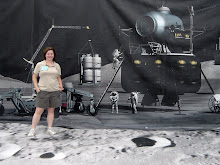
You might have seen this Press Release last week describing a little patch of soil that turned out to be a really incredible find. Since Spirit's right front wheel stopped working, the rover drives backwards dragging the stuck wheel around. When there's soft soil or dust, this effectively digs a small trench and churns up subsurface material. Most times, the soil on Mars (that's soil in the planetary sense - no organics like soil on Earth) is pretty uniform and looks the same from place to place to place. Sometimes though, Spirit has turned up light-colored material like Tyrone, Arad, and Paso Robles. Those bright materials have turned out to be sulfate salts - generally Ca-sulfate (gypsum) - which forms on Earth as a precipitate from liquid water. Those deposits show us that liquid water played a role here in the soils somehow, maybe as a shallow lake or ephemeral playa (not too different from New Mexico actually).
As we headed to Home Plate, Spirit's wheel churned up another bright patch. By this point, most of the team wasn't freaking out about every white patch and it was actually the APXS team leader who pointed it out and asked for a picture. When we looked at it in Pancam color and with the Mini-TES, it was immediately clear it was something new. The Mini-TES is a remote-sensing instrument that collects light in the near-infrared spectrum, beyond where our eyes can see. The TES stands for Thermal Emission Spectrometer. You've probably seen infrared cameras on TV, and we just had someone come up and image our home in infrared to detect water leaks, and the TES works in a siliar way - it passively collects thermal emission from the objects around it. The shape of the thermal emission spectrum reflects the mineralogy of the rock, so we use Mini-TES to remotely sense the mineral makeup of nearby rocks. When Mini-TES looked at the white patch, it showed something totally new - the presence of free SiO2.
SiO2 is silica or silicon dioxide, better known on Earth as quartz, sand, opal, chert, amethyst, jasper, or agate, just to name a few. If you're a rockhound, you know that quartz minerals form where there's lots of water, like fluids flowing through a vein or vapors depositing on springs. We took better Mini-TES spectra to distinguish what form the SiO2 was in and it looks most like opal, which means the SiO2 is not like quartz crystals but rather kind of amorphous, more like deposits found at hot springs. So that's not to say there was a hot spring here, but since we're right next to Home Plate - a structure we think was caused by hot lava interacting with groundwater - we really think they might be linked!
OK, that's cool you think, but why the heck do we need to put a press release every time there's something that might be water-related? Well, first it *is* kind of cool. No other mission has ever found anything like SiO2, even though it's been speculated to exist for decades. Second, remember that this continues to be a publicly-funded mission and continues to fullfill its objectives. Every public program needs to report its progress - you can be cynical in saying it's to continue to get funding, and while obviously I adore working on this mission, I would find funding somewhere else, so I'll take the non-cynical view that we have an enthusiasm as well as an obligation in reporting to the public all the good things we're doing, as do all missions.

1 comment:
Hey Science Girl,
Any comments on this story?
http://space.newscientist.com/article/dn12026-mars-rover-finds-puddles-on-the-planets-surface.html
Post a Comment